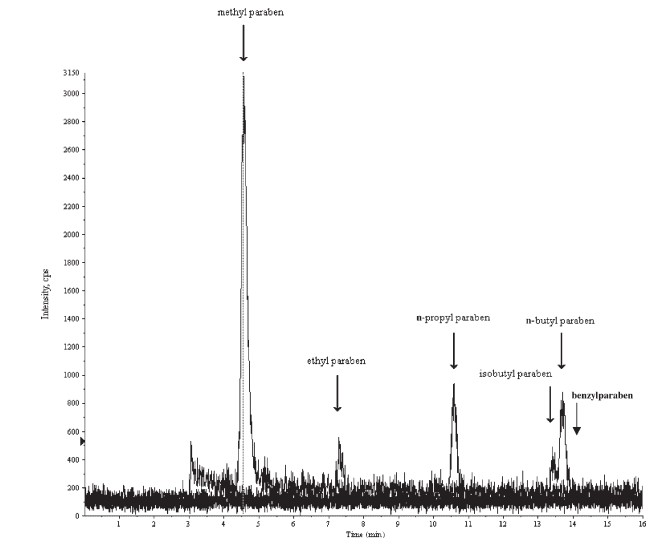We have got used to seeing the phrase “paraben-free” on certain products next to the list of ingredients on the packaging; in fact, we sometimes even look specifically to see if a product contains them. But have you thought about why that is? It turns out it’s not as simple as it might seem. In order to demystify the contradictory opinions about parabens, we need to look at the scientific studies carried out to date on the effects these chemicals have on our body and on the environment.
What are parabens and why do so many cosmetic products contain them?
Parabens are a class of chemical components that are used as preservatives in many personal care products, including lotions, shampoos, creams, toothpastes and make-up. There are six types of parabens that are commonly used in cosmetic products: methyl-, ethyl-, propyl-, isopropyl-, butyl- and isobutylparabens, all of which help to prevent bacterial growth and extend the shelf life of these products.
But what’s so bad about them?
It is clearly of great importance to keep products free from bacteria, and parabens achieve this. However, as well as preventing the development of bacteria, they can also cause serious harm to our body. These chemicals (particularly long-chain parabens) are considered potential endocrine-disrupting chemicals. Endocrine disruption basically means that our hormonal system stops working properly, and our hormonal system is what drives all our body’s functions. Therefore, any disturbance of our body functions can alter growth, development, reproduction and even brain function, among other things. Specifically, parabens mimic oestrogen, the steroid sex hormone responsible for the development of female secondary sex characteristics, and they can interfere with its production.
The alarm was first raised in 2004, when several oncologists from the University of Reading (UK) carried out a study of cancer tissues and traces of parabens were found in 90% of the biopsy samples from women with breast cancer (Darbre PD, Aljarrah A, Miller WR, Coldham NG, Sauer MJ, Pope GS. Concentrations of parabens in human breast tumours. J Appl Toxicol. 2004 Jan-Feb; 24(1):5-13). This supports the theory that parabens may contribute to the development of breast cancers, as oestrogen receptor is expressed in up to 70% of these tumours (James G. Wagner, Michigan State University).

Figure 1. HPLC-MS/MS chromatograms of methylparaben, ethylparaben, n-propylparaben, isobutylparaben and n-butylparaben in an extract of human breast tumour. Tumour tissue was extracted, chromatographed on a Hypersil Elite HPLC column and detected by mass spectrometry. The arrows indicate the peaks found in the chromatograms. Benzylparaben was not observed.
Research has also shown that they cause allergies and skin problems, increase the risks of toxicity, cause hormonal alterations, increase the production of free radicals and are related to reproductive problems such as infertility.
In addition to all these negative effects on our body, there are also concerns for the environment. Parabens are rinsed off and go down the drain, ending up dangerously dispersed in the environment. Residues of parabens have been found in water samples, river sediment, animals (birds and fish, among others), human urine, sperm and even breast milk, which shows they are so tiny that they return to our body through the water we drink.
If they’re so bad, why haven’t they been banned?
The answer is very simple: many companies have invested a great deal in the use of parabens in order to keep their costs low and their profit margins high. Aside from any harm they may cause, the preservative action of parabens is very effective, so most companies in the cosmetic industry intend to keep them in their products because banning them would mean investing a lot of money and reformulating thousands of products with safer but more expensive preservatives.
What has been achieved is that EU legislation regulates the maximum quantities contained in a single product. The total maximum concentration allowed in consumer products is 8 g of parabens per kg of cosmetic product, provided no individual paraben is present at a concentration of more than 4 g/kg.
How to identify whether a product contains parabens
In order to identify the presence of parabens in a cosmetic product, its composition must be located. The ingredients list will show all the components from which the product is made, ordered from highest to lowest concentration. Parabens appear as benzylparaben, butylparaben, ethylparaben (sometimes disguised as E214), isobutylparaben, isopropylparaben, methylparaben (sometimes disguised as E218) and propylparaben (sometimes disguised as E216).
In short, it is vitally important to look at a product’s ingredients in order to analyse its benefits and its possible contradictions and side effects. At REDENHAIR, all our products are paraben-free, containing alternative preservatives that are environmentally friendly and do not have negative effects on our body.


 GREYVERSE™, ACTIVE PRINCIPLE OF REDENHAIR ANTI-GREYING RITUAL
GREYVERSE™, ACTIVE PRINCIPLE OF REDENHAIR ANTI-GREYING RITUAL
 Myths about hair fibers Are they harmful to our hair?
Myths about hair fibers Are they harmful to our hair?
 MANY CELEBRITIES ALREADY USE OUR LASER HELMET (LLLT)
MANY CELEBRITIES ALREADY USE OUR LASER HELMET (LLLT)
 REDENHAIR REGENERATING BRUSH VS REDENHAIR REGENERATING HELMET
REDENHAIR REGENERATING BRUSH VS REDENHAIR REGENERATING HELMET
 ENJOY THE BENEFITS OF COLLAGEN WITH REDENHAIR
ENJOY THE BENEFITS OF COLLAGEN WITH REDENHAIR
 SANDALWOOD, ALLY IN THE FIGHT AGAINST ALOPECIA
SANDALWOOD, ALLY IN THE FIGHT AGAINST ALOPECIA
 THE PHASES OF A HAIR TRANSPLANT AND THE ALTERNATIVE REDENHAIR OFFERS YOU
THE PHASES OF A HAIR TRANSPLANT AND THE ALTERNATIVE REDENHAIR OFFERS YOU
 WHAT IS FEMALE ALOPECIA FOR AGING AND HOW TO TREAT IT?
WHAT IS FEMALE ALOPECIA FOR AGING AND HOW TO TREAT IT?
 LATEST TECHNOLOGY FOR HAIR BASED ON LASER LIGHT
LATEST TECHNOLOGY FOR HAIR BASED ON LASER LIGHT
 Saltpeter and hair
Saltpeter and hair
 What is dandruff? What types of dandruff are there?
What is dandruff? What types of dandruff are there?
 At what age can we start using anti-hair loss products?
At what age can we start using anti-hair loss products?

